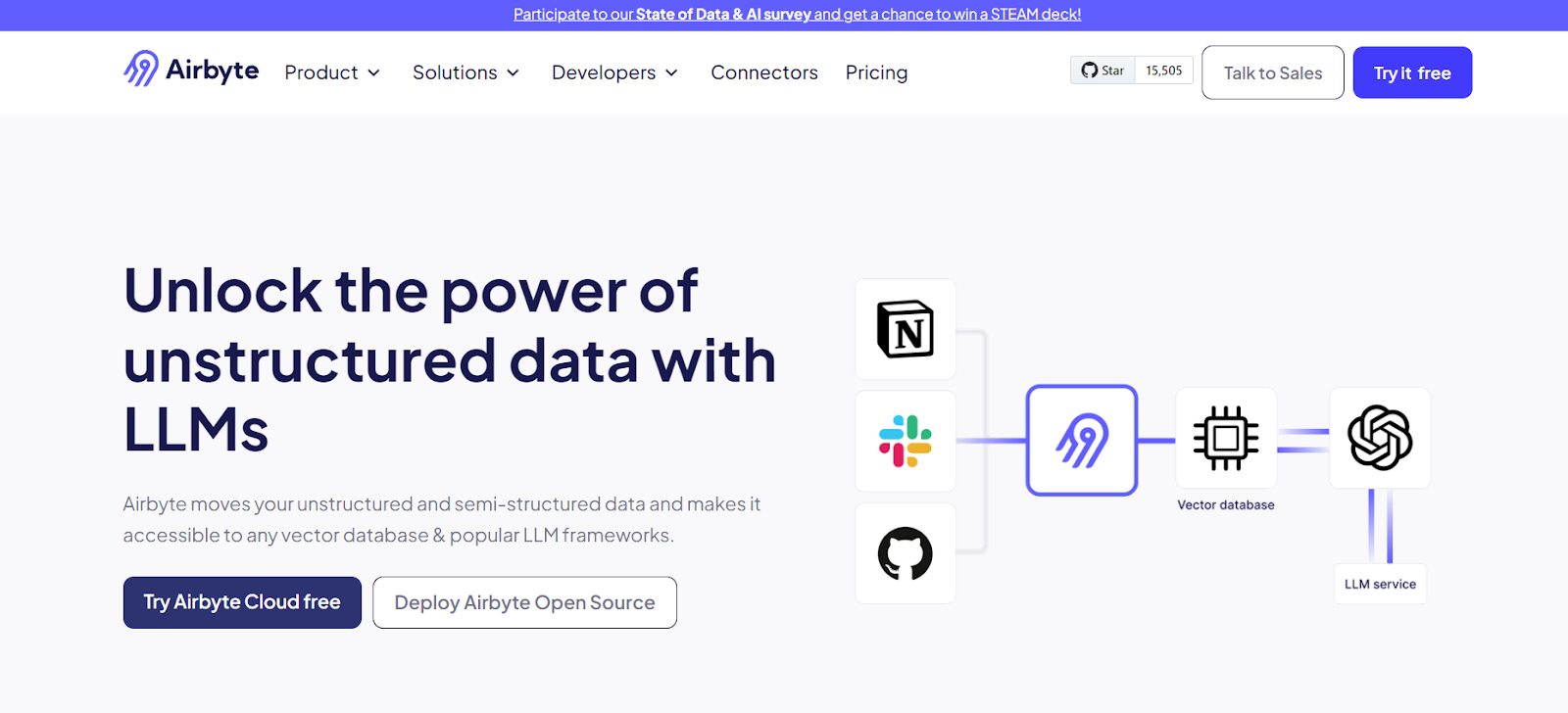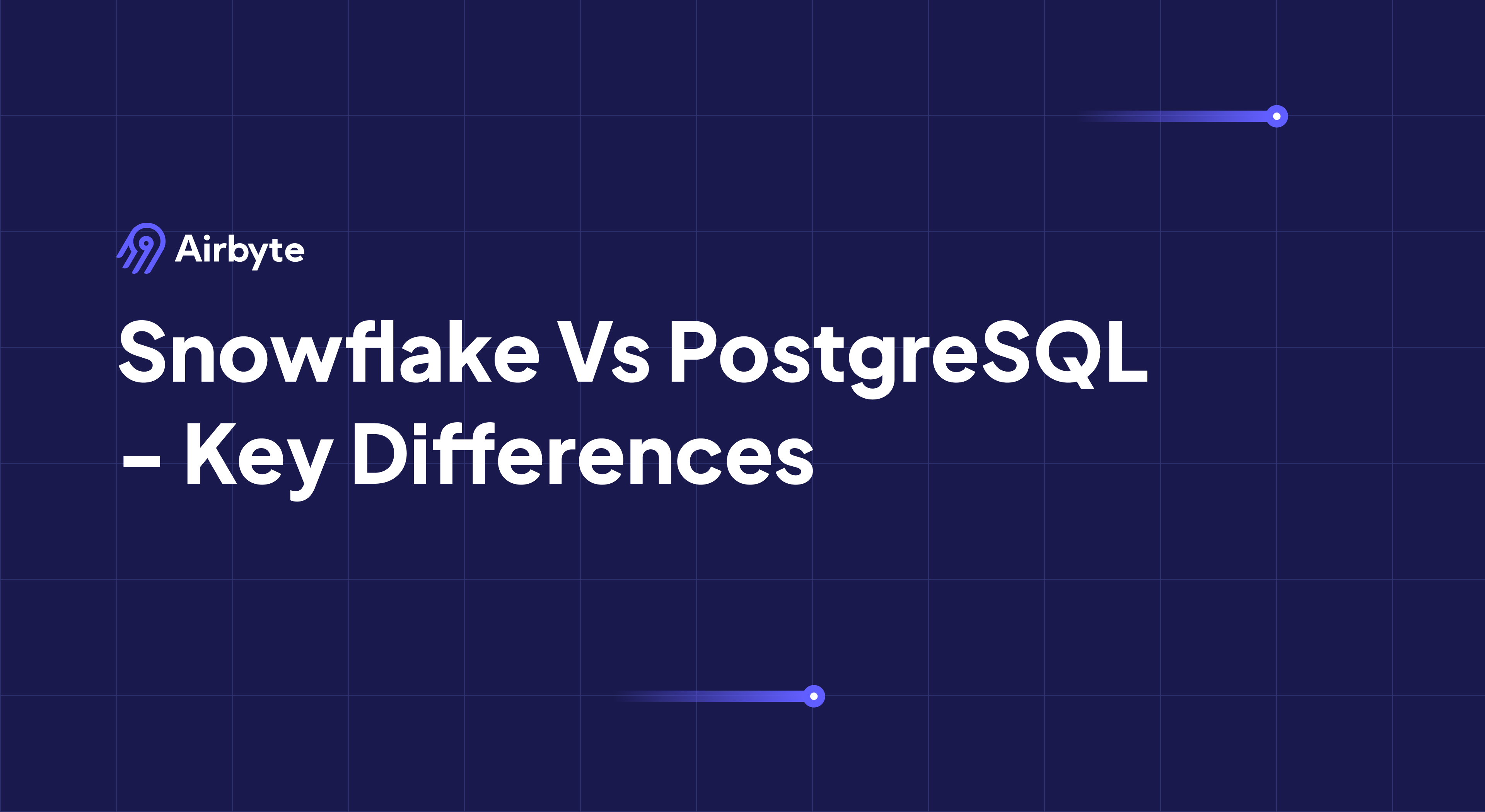Snowflake Vs PostgreSQL - Key Differences
Summarize this article with:
✨ AI Generated Summary
For efficient data management, it’s crucial to opt for an appropriate database for your workflows. Postgres and Snowflake are two of the most popular database solutions available. Both of these options are reliable, have powerful features, and offer smooth performance. However, they serve different purposes that can suit your varied needs.
This article explores the key differences between Snowflake vs PostgreSQL and highlights the important factors you should consider when picking the right database. With a better understanding of which tool aligns best with your use cases, you can leverage it to get the most out of your data.
What is Snowflake?

Snowflake is a cloud-based platform that revolutionizes data warehousing by offering unparalleled data storage and analytics capabilities. Unlike traditional databases, Snowflake’s exceptional architecture ensures impressive scalability and flexibility, even for vast amounts of data.
With such flexibility, Snowflake efficiently allows you to handle structured and semi-structured data; it natively supports formats like JSON, Avro, and Parquet. You can integrate and analyze varied data sources in Snowflake without extensive transformations.
Key Features of Snowflake
- Scalable Architecture: Snowflake automatically scales to accommodate fluctuating workloads, ensuring fast performance with minimal manual intervention. It also offers efficient cost management by allowing you to scale storage and computing resources independently.
- Zero Copy Cloning: It supports quick and cost-effective duplication of databases or tables without physically copying data. Zero copy cloning helps you to instantly create databases, schemas, and tables without additional storage costs.
- Historical Data Retrieval: Snowflake’s Time Travel feature enables you to easily access historical data from a specific point in the past. This can help you retrieve data that may have been accidentally changed or deleted.
- Data Sharing: You can share live data between Snowflake accounts without moving or copying data for streamlined collaboration.
- Multi-Cloud Support: Snowflake is compatible with major cloud platforms such as AWS, Azure, and Google Cloud, providing flexibility and preventing vendor lock-in.
What is PostgreSQL?

PostgreSQL, often referred to as Postgres, is an open-source object-relational database management system (RDBMS) known for its reliability, adaptability, and compliance with SQL standards. It is designed to handle large volumes of data efficiently and securely. PostgreSQL enjoys a 17.31% market share in the relational database category, demonstrating its popularity.
One of Postgres's notable features is its flexibility; it allows you to create your own data types and functions. You can also store various types of data, including JSON, making PostgreSQL versatile for managing both structured and semi-structured data. It is particularly effective at handling unstructured data commonly found in modern applications, offering ease of management.
Key Features of PostgreSQL
- ACID Compliance: PostgreSQL adheres to the four ACID principles: atomicity, consistency, isolation, and durability. The compliance ensures that transactions are processed safely and securely, allowing Postgres to handle large amounts of data efficiently.
- Expandability: It is highly scalable and supports various data types. PostgreSQL’s expandability ensures that it can handle growing data volumes without compromising performance.
- Customization: PostgreSQL offers extensive customization options through user-defined functions, operators, and aggregates. It also supports extensions, allowing you to add new features and tailor the database to meet specific application needs.
- Multi-User Access: PostgreSQL's Multi-Version Concurrency Control (MVCC) feature allows multiple users to access the same data simultaneously without conflicts.
- Security Features: It offers robust security features such as role-based access control, SSL encryption for data in transit, and advanced authentication methods like LDAP, GSSAPI, and SCRAM-SHA-256.
Postgres vs Snowflake
The main difference between Snowflake and Postgres is that Snowflake is a cloud-native data warehouse optimized for large-scale analytics and SQL queries, while Postgres is a relational database designed for transactional workloads and complex queries.
Snowflake vs Postgres: Architecture
Snowflake uses a cloud-native, multi-cluster shared data architecture that separates the compute and storage layers. The separation enables independent scaling of each resource and dynamic adjustment of compute power without affecting storage capacity. It is particularly advantageous for large-scale data analytics.
Snowflake’s architecture is designed to support high concurrency. It uses multi-cluster virtual warehouses called compute clusters, which can access the same shared data simultaneously without degrading the performance. Snowflake also supports automatic scaling to match the demands of concurrent tasks, ensuring consistent performance.
In contrast, PostgreSQL follows a traditional monolithic RDBMS architecture involving tightly-coupled compute and storage resources. Data in PostgreSQL is organized in tables with rows and columns, following a relational model. This structure is highly effective for transactional loads that require quick and consistent access to smaller datasets.
PostgreSQL is ideal for Online Transaction Processing (OLTP) environments. It typically relies on vertical scaling or sharding, which can introduce complexity and management overhead.
While PostgreSQL ensures data accuracy and supports complex queries, it requires more effort to handle massive datasets compared to Snowflake.
Snowflake vs Postgres: Cost
Snowflake uses a pay-as-you-go pricing model that separates storage and computing costs. Virtual warehouses in Snowflake can automatically scale based on demand, which makes computing costs flexible but volatile if not managed well.
Standard storage costs in Snowflake are typically based on a per-terabyte model, with extra features like data sharing and time travel potentially increasing the overall costs. In the US, storage costs start at about $23 per terabyte for pre-purchased capacity. For on-demand usage, the charge is $40 per terabyte. Although Snowflake’s pricing is good for variable workloads and large-scale analytics, it can get pricey if computing usage isn’t optimized.
Since PostgreSQL is an open-source platform, there are no direct licensing costs. You pay for the infrastructure your apps run on. This can be on-premise or cloud-hosted services, such as AWS RDS or Azure Database.
The overall expenses are influenced by the choice of instance type, storage space usage, and additional features like backups or high availability. While PostgreSQL may be cost-effective initially, especially for smaller, steady workloads, it can get expensive over time because it is harder to maintain, tune, and scale.
Snowflake vs Postgres: Use Cases and Suitability
Snowflake is an efficient solution for handling large-scale data analytics across diverse industries. In retail, it facilitates real-time transaction analysis, allowing you to track sales trends, manage reward programs, and analyze seasonal impacts. In healthcare, Snowflake facilitates the storage of massive datasets for public health research, streamlining data ingestion and sharing across medical centers to enhance patient outcome studies.
Snowflake’s elasticity and zero-copy cloning are valuable for machine learning applications in finance and other sectors. These capabilities assist in efficient data preparation and model training with real-time insights.
On the other hand, PostgreSQL is widely adopted in real-life applications that require complex transactions and strong data integrity. E-commerce platforms like Shopify and Zalando rely on PostgreSQL to manage customer transactions, inventory management, and order processing. Companies like Uber use PostgreSQL with the PostGIS extension for geospatial data management, which is essential for mapping and location-based services.
Factors to Consider When Choosing Snowflake vs Postgres
1. Scalability and Performance
Why Choose Snowflake?
Snowflake's architecture separates computing and storage, allowing them to scale independently. It supports multiple concurrent queries via multi-cluster virtual warehouses and auto-scaling, which dynamically adjusts computation resources based on demand.
Why Choose PostgreSQL?
PostgreSQL works very well for transactional workloads and general-purpose applications but scales primarily through vertical scaling. Powerful hardware upgrades might be required to enhance performance.
2. Ease of Use and Management
Why Choose Snowflake?
Snowflake is a fully managed service that allows you to automate tasks such as scaling, optimizing performance, backups, and security updates. It helps with cost and time efficiency, allowing you to focus on data analytics instead of managing databases.
Why Choose PostgreSQL?
PostgreSQL offers significant flexibility, allowing you to customize and tailor the database to meet specific application needs. While it requires more hands-on management, it provides extensive control over performance settings, query optimization, and memory allocation.
3. Security and Compliance
Why Choose Snowflake?
Snowflake has strong security features, including end-to-end encryption, data masking, and secure key management. It also complies with various standards like GDPR, HIPAA, and PCI DSS, making it a reliable option for industries dealing with sensitive data.
Why Choose PostgreSQL?
PostgreSQL offers a comprehensive set of security features designed to meet compliance standards and provide data privacy. It supports SSL connections for encrypted communication and role-based access control to manage user permissions at a granular level. PostgreSQL also provides data encryption at rest, ensuring that stored data remains protected.
With its integration of advanced authentication protocols like LDAP and GSSAPI, PostgreSQL guarantees secure authentication methods.
4. Integration and Ecosystem Support
Why Choose Snowflake?
Snowflake supports cloud platforms like AWS, Azure, and Google Cloud and works well with many other data integration, analytics, and business intelligence tools. The platform’s ecosystem support simplifies the development and management of data pipelines, enhancing integration across various tools and technologies.
Snowflake’s extensive support for third-party tools and APIs enables a unified data ecosystem. It facilitates collaboration and data sharing across teams and platforms. The platform’s compatibility with popular tools like Tableau, Power BI, and Apache Spark ensures efficient data visualization, analysis, and processing.
Why Choose PostgreSQL?
PostgreSQL is an excellent choice if you need a flexible database solution that integrates with a wide range of technologies. It offers robust APIs and extensive support for third-party applications, including popular tools like Tableau and Looker. With its support for Foreign Data Wrappers (FDW), Postgres allows you to integrate seamlessly with external databases such as MongoDB and MySQL. It enables you to work with diverse data sources in a unified environment.
Streamline PostgreSQL and Snowflake Data Integration with Airbyte
When working with high-volume data, it is common to move some of your data or consolidate various data sources for downstream tasks. Airbyte, an AI-enabled data integration tool, can help you with this. Whether you choose PostgreSQL or Snowflake as your database, Airbyte can simplify data integration to ensure smoother data flows.

Airbyte's library of 400+ pre-built connectors allows you to move data from Snowflake to PostgreSQL or any other source-destination combination. It has several other features that streamline data preparation tasks for further analysis and reporting.
- Change Data Capture: You can use Airbyte’s CDC feature to detect any data changes occurring at the source and reflect them to the destination. This helps you keep track of updates and ensure data consistency.
- PyAirbyte: With Airbyte’s Python library, PyAirbyte, you can build developer-friendly pipelines. It allows you to extract data from disparate sources using Airbyte connectors and load it to SQL caches such as DuckDB, Postgres, Snowflake, and BigQuery. This cached data is compatible with Pandas library, SQL-based tools, and AI frameworks like LangChain and LlamaIndex to facilitate building LLM-powered applications.
- Data Transformation: Airbyte empowers you to create and run custom transformations using the dbt Cloud integration. You can also perform RAG transformations, such as chunking, by integrating Airbyte with popular LLM frameworks like LangChain or LlamaIndex.
To learn more about how you can leverage Airbyte within your data implementations, contact the Airbyte expert or refer to the official documentation.
Summary
The Snowflake vs PostgreSQL comparison displays the different strengths of each platform suited to specific use cases.
With its cloud-native architecture and automatic scaling, Snowflake is designed for large-scale analytics. It is ideal for dealing with vast amounts of data that need real-time processing. Snowflake's fully managed service and ease of use also reduce administrative overhead.
On the other hand, PostgreSQL is an open-source relational database that is well-suited for transactional workloads and general-purpose applications. It offers extensive customization, strong data integrity, and scalability options but requires more manual intervention.
Based on your data needs, you can choose the platform that will be a long-term relevant solution for your organization.

